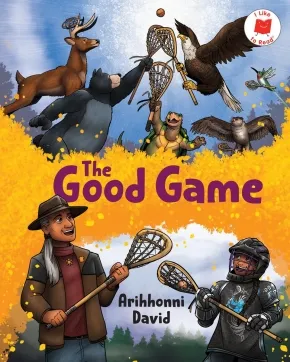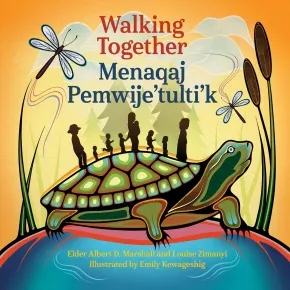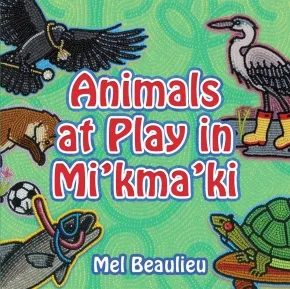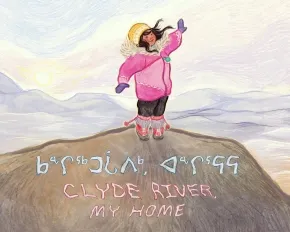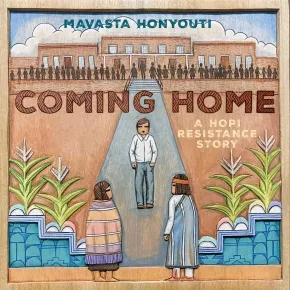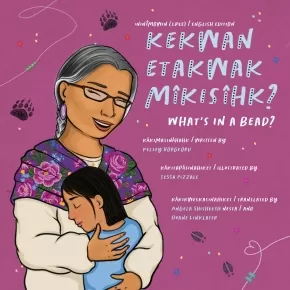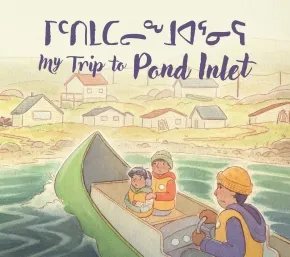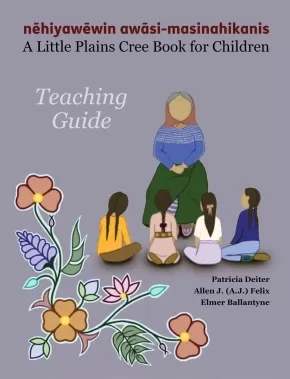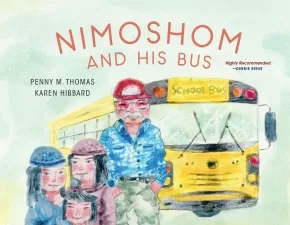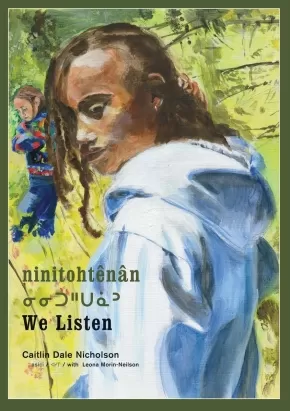
Indigenous Literacy
16
-
30
of
166 Results;
Sort By
Go To
of 12
The Good Game (PB)
$12.49
Format:
Paperback
Text Content Territories:
Indigenous;
ISBN / Barcode: 9780823460809
Synopsis:
Synopsis:
How can the small mouse and squirrel play lacrosse with the big animals? A fun Native American tale that first graders can read on their own.
A game of lacrosse is about to begin—with the four-legged animals facing off against the winged animals. Mouse and Squirrel want to join!
But Bear and Deer won’t let animals so small on their team. The birds would welcome the small animals, but Mouse and Squirrel can't fly. The winged team has a clever plan.
This Native American tale about the origin of the bat and flying squirrel is framed by a grandfather sharing a story with his grandson.
Educator & Series Information
Phonics features are noted on the copyright page.
This book has been officially leveled by using the F & P Text Level Gradient(TM) Leveling System. It is a Level I for Grade 1.
The award-winning I Like to Read® series focuses on books for kindergarteners and first graders. Acclaimed author-illustrators create original, high-quality illustrations that support comprehension of simple text and are fun for kids to read again and again with their parents, teachers or on their own!
A Junior Library Guild Gold Standard Selection!
Educator Information
Recommended for ages 4 to 8.
Additional Information
32 pages | 7.77" x 9.99" | Paperback
Walking Together / Menaqaj Pemwije’tulti’k
$24.99
Format:
Hardcover
Text Content Territories:
Indigenous Canadian; First Nations; Mi'kmaq (Mi'gmaq);
ISBN / Barcode: 9781834020174
Synopsis:
Synopsis:
This bestselling and award-winning introduction to Etuaptmumk—the gift of multiple perspectives also known as Two-Eyed Seeing—is now available in a bilingual edition that celebrates the Mi’kmaw language and our connections to nature.
Elder Albert D. Marshall is a leading environmental voice who has brought forward the concept of Etuaptmumk, honoring and braiding both Indigenous and non-Indigenous knowledges and ways of knowing for the benefit of all. Walking Together is grounded in this, as well as in the concept of Netukulimk, meaning to protect Mother Earth for the ancestors and for present and future generations. The journey in Walking Together nurtures respectful, reciprocal, responsible relationships with the Land and Water, with plant life and animals, and with other-than-human beings.
Translated by Barbara Sylliboy and Arlene Stevens, Eskasoni First Nation, Unama’ki (Cape Breton), Nova Scotia, the dual-language text in Mi’kmaw and English furthers Elder Marshall’s lifelong work preserving cultural beliefs and creating a strong vision for his people and for the future. Elder Marshall and Louise Zimanyi are working together to promote Land-based learning through storytelling, an approach that has global relevance for protecting biodiversity, climate action, and resilience. Emily Kewageshig’s evocative artwork illustrates the beauty of connecting with nature and encourages readers to strengthen their relationships to the world around them.
Educator Information
Recommended for ages 4 to 7.
Introduces the concept of Two-Eyed Seeing (the gift of multiple perspectives) to young readers.
Bilingual Edition: Mi’kmaw and English.
This book is available in English: Walking Together
Additional Information
40 pages | 9.00" x 9.00" | Hardcover
Animals at Play in Mi'kma'ki (BB)
$16.95
Format:
Board Book
Text Content Territories:
Indigenous Canadian; First Nations; Mi'kmaq (Mi'gmaq);
Grade Levels: Preschool; Kindergarten;
ISBN / Barcode: 9781459507449
Synopsis:
Synopsis:
In this fun board book for young kids, turtles skateboard, salmon snorkel, bears take photos and otters frolic with floaties!
Mi’kmaw artist Mel Beaulieu’s lively modern take on traditional beadwork brings these animals to life. Mi’kma’ki’s most iconic animals are portrayed in this colourful and whimsical book.
Mi’kmaw names (and pronunciation guides) make this a great introduction to contemporary Mi’kma’ki for very young children.
Educator Information
Recommended for ages 2 to 5.
Additional Information
6.53" x 6.53 | Board Book
Clyde River, My Home
$16.95
Artists:
Format:
Paperback
Grade Levels: Preschool; Kindergarten;
ISBN / Barcode: 9781774507711
Synopsis:
Synopsis:
Clyde River, Nunavut is a great place to live! In this bilingual picture book, Louise tells us about all the things she and her family like to do. With the annual fishing derby in the spring and Hamlet Day in the summer, there are lots of fun things to do throughout the year. Winter brings plenty of time to connect with people in the community and support each other. Learn about the different activities people do in each season in Clyde River, its landmarks, and the amazing wildlife you can see there, like bowhead whales.
Educator & Series Information
Recommended for ages 3 to 5.
Dual-Language: English & Inuktitut
This book is part of the Community Connections series.
Additional Information
27 pages | 8.00" x 10.00" | Paperback
Coming Home: A Hopi Resistance Story
$28.99
Artists:
Format:
Hardcover
ISBN / Barcode: 9781646144570
Synopsis:
Synopsis:
From master Hopi woodcarver Mavasta Honyouti, the story of his grandfather’s experience at a residential boarding school and how he returned home to pass their traditions down to future generations.
When Mavasta Honyouti was a boy he would go with his grandfather to their cornfield, watching him nurture every plant. During breaks, his grandfather would take out a piece of paako root and use his pocketknife to whittle away. He made beautiful carvings that Mavasta would later learn to do himself.
But Mavasta would often wonder: what was his kwa’a like when he was a boy? And one day, he heard the story.
Mavasta’s grandfather, like many Native American children across the country in the late 19th and early 20th century, was forced to leave his Hopi reservation as a child and go to a residential boarding school far away. There, the government cut his hair, punished him for speaking his native language, and gave him a new name. But Mavasta's grandfather never forgot who he was – or where he came from – and he tried to escape again and again. Finally, he made it back to their reservation.
In later years, Mavasta’s kwa’a chose a simple life, taking great care of his family just like he took great care of his plants. His son and later his grandson became acclaimed Hopi katsina woodcarvers, just like him. Coming Home: A Hopi Resistance Story is a deeply personal book – written in both English and Hopi – that features sixteen stunning original painted wood carvings. It is an unforgettable testament to one man rising above a painful piece of history to keep the light of his family and culture alive.
Educator Information
Recommended for ages 4 to 8.
Dual-language: English and Hopi.
Additional Information
48 pages | 9.00" x 9.20" | Hardcover
It Bears Repeating
$23.99
Artists:
Format:
Hardcover
Text Content Territories:
Indigenous Canadian; Inuit;
ISBN / Barcode: 9781774880555
Synopsis:
Synopsis:
This beautifully crafted picture book celebrates one of the world's most awesome animals: the polar bear. Evocative but simple text by award-winning musician and artist Tanya Tagaq is accompanied by striking art in this classic counting book.
Beginning with 1 proud polar bear standing tall and ending with 10 bears waving goodbye, this delightful counting book shows polar bears in all their forms: slippery and fast, crafty and cool, hungry and proud. Tanya has created a story meant to be read aloud, incorporating simple Inuktitut words and using her keen ear for the musical sound of language.
This book is joyful, powerful, clever and striking — much like the bears who sniff, slide, swim, hunt, play and dance through its pages. And when you get to the last page, you won't be able to resist going back to repeat the journey!
Educator Information
Recommended for ages 3 to 7.
Concepts: Counting & Numbers; Animals - Polar Bears.
This book is meant to be read aloud and incorporates simple Inuktitut words.
Additional Information
24 pages | 10.50" x 9.00"
It Is Good to Live in Beautiful Arctic Bay
$16.95
Artists:
Format:
Paperback
Text Content Territories:
Indigenous Canadian; Inuit;
Grade Levels: Preschool; Kindergarten;
ISBN / Barcode: 9781774507933
Synopsis:
Synopsis:
Lucy loves living in Arctic Bay. There are so many things to do in each season! In the winter during "the great darkness," Lucy likes watching the northern lights. She is always excited to welcome the sun back in the spring. In the summer, Lucy can't wait to go blueberry picking, camping, and eat pissi. Follow along with Lucy as she takes readers through the seasons and shares all her favourite things about living in beautiful Arctic Bay.
Educator & Series Information
Recommended for ages 3 to 5.
Dual-Language: English and Inuktitut.
This book is part of the Community Connections series.
Additional Information
29 pages | 9.00" x 8.00" | Paperback
kekwan etakwak mîkisîhk / What’s in a Bead?
$21.95
Artists:
Format:
Hardcover
Text Content Territories:
Indigenous Canadian; First Nations; Anishinaabeg; Cree (Nehiyawak);
ISBN / Barcode: 9781772603675
Synopsis:
Synopsis:
There are many stories in a bead. We must listen to the stories they tell us.
Tessa loves how her grandmother always smells of campfire stories. Mom says it’s because Kohkom spends her days sewing beautiful beads onto smoked hides. Inspired, Tessa asks Kohkom to teach her beading, but first she must listen and learn about the many stories held in a bead.
A celebration of Cree craftsmanship, language, and learning. The loving exchange of knowledge between Tessa and her Kohkom will be familiar to many children. Readers will learn that different Indigenous communities have different beadwork techniques, and that this traditional art form is alive and thriving today.
Reviews
"The story is a beautiful look into the importance of beading in our communities and the ways that this art practice ties us together as families and communities." — Nancy Cooper, First Nations Consultant for the Southern Ontario Library Services and coordinator for First Nation Communities Read
Educator Information
Recommended for ages 6 to 8.
This dual language edition contains the story in both Ininîmowin (Cree, N-dialect) and English.
Translators: Duane Linklater & Angela Shisheesh
Duane is Omaskêko Ininiwak and currently lives in North Bay, Ontario. He earned a Master of Fine Arts from Bard College and a Bachelor of Native Studies with a focus in Cree language from the University of Alberta. Linklater is lifelong learner of the Cree language and credits the many Elders, including his kohkom Agnes Hunter, for teaching and sharing the language.
Angela is a Cree translator at Ojibway & Cree Cultural Centre based in Timmins, Ontario
An English-only version is available: What's in a Bead?
This book is available in French: Le pouvoir d'une perle
Additional Information
24 pages | 8.50" x 8.50" | Hardcover
My Trip to Pond Inlet
$16.95
Artists:
Format:
Paperback
Text Content Territories:
Indigenous Canadian; Inuit;
ISBN / Barcode: 9781774507728
Synopsis:
Synopsis:
One rainy day, Solomon is playing inside with his sister. Their mom is cooking polar bear meat in a big pot of water. Suddenly, he trips and burns his arm in the pot of boiling water! The burn is so bad that he must travel to the health centre in the neighbouring community of Pond Inlet. Solomon has to stay in Pond Inlet until his arm heals. Even though Solomon misses his home, he likes playing with the other kids at the health centre and exploring the new and exciting community of Pond Inlet.
Educator & Series Information
Recommended for ages 5 to 7.
In My Trip to Pond Inlet children learn about the responsibility of being safe around hot water and taking care of themselves after an injury.
Dual-Language: English and Inuktitut
This book is part of the Community Connections series.
Additional Information
40 pages | 9.00" x 10.00" | Paperback
nēhiyawēwin awāsi-masinahikanis: A Little Plains Cree Book for Children—Teaching Guide
$74.95
Format:
Coil Bound
Text Content Territories:
Indigenous Canadian; First Nations; Cree (Nehiyawak); Plains Cree;
Reading Level: N/A
ISBN / Barcode: 9781778690273
Synopsis:
Synopsis:
A Little Plains Cree Book for Children—Teaching Guide contains lesson plans, student assignments, and other helpful information for teaching the Plains Cree language—a companion to nēhiyawēwin awāsimasinahikanis: A Little Plains Cree Book for Children: A Reference for Teaching the Plains Cree Language, the content of which focuses on terms familiar to the First Nations Cree people of Saskatchewan and follows curriculum for Kindergarten to Grade 12.
Educator Information
Find the companion resource here: A Little Plains Cree Book for Children: A Reference for Teaching the Plains Cree Language
A colouring book companion is here: A Little Plains Cree Colouring Book: Plains Cree People
Additional Information
128 pages | 8.50" x 11.00" | Spiral Bound
Nimoshom and His Bus (PB)
$14.00
Artists:
Format:
Paperback
Text Content Territories:
Indigenous Canadian; First Nations; Cree (Nehiyawak);
Grade Levels: Preschool; Kindergarten;
ISBN / Barcode: 9781774921166
Synopsis:
Synopsis:
In this warm and joyful picture book highly recommended by Debbie Reese, children learn Cree from Nimoshom, their school bus driver.
Based on the author’s memories of her grandfather, Nimoshom is not your average bus driver. He loves to drive the school bus, tell silly stories, and share his language with the kids who ride his bus.
Nimoshom and His Bus introduces readers to common Cree words and phrases alongside the common childhood experience of riding the school bus. A Cree word list is included in the back of the book.
Reviews
"Through accessible language and engaging visual resources, readers are introduced to basic Cree as Nimoshom responds in this language to the children who ride his bus.... The illustrator’s varying the visuals between full double spreads and single page illustrations keeps the pacing lively. Amidst a rural fall setting, with woodland animals, children, and the school bus, Nimoshom’s humorous nature shines through these gentle illustrations. At the end of this story, you just want to give Nimoshom a great big hug!"— Anita Miettunen, CM: Canadian Review of Materials
"In this bilingual book, readers follow a bus driver picking up kids and dropping them off before and after school. Like the students on the bus, readers quickly learn that the driver's native language is Cree, and he often speaks to them in his native language. Readers learn that "Nimoshom" means "my grandfather" and that "Ekosani" means thank you" as the author (of Cree descent herself) weaves Cree words into the text, and each new spread almost feels like a gentle wave: yes, we're subtly learning new words, but it never feels strenuous or forced, rather it's calm and poetic."— Let's Talk Picture Books
"While Penny M. Thomas' story is not a plot-driven allegory or a message-based lesson, Nimoshom and His Bus is a sweet introduction to some simple Cree words in the context of a common-place activity for many children.... Karen Hibbard who uses watercolours and pastels to create a gentle background for Nimoshom's day on his bus gives the story a grassroots mood, highly appropriate for a routine day of activity and interaction for this bus driver and his charges. It's very relatable."— Helen Kubiw, CanLit for Little Canadians
"If you're a regular reader of AICL, you know that we're always delighted by books by Native writers--especially ones set in the present. Books like Nimoshom and His Bus provide Native children with mirrors that non-Native children find in abundance.... I highly recommend Nimoshom and His Bus! It'd be a simple thing to use other Native words in addition to--or instead of--the Cree words in the book."— Debbie Reese, American Indians in Children's Literature
Educator Information
Recommended for ages 3 to 5.
Additional Information
24 pages | 9.50" x 7.50" | Paperback
ninitohtênân / We Listen
$21.99
Artists:
Format:
Hardcover
Text Content Territories:
Indigenous Canadian; First Nations; Cree (Nehiyawak);
ISBN / Barcode: 9781773068596
Synopsis:
Synopsis:
The third book in the Nôhkom series, in Cree and English, tells a story about gathering leaves for Labrador tea, while listening in different ways.
A child, her family and her friend have arrived at their favorite picnic spot by the lake, but before they eat lunch Nôhkom suggests they pick leaves for Labrador tea. Once among the trees, Nôhkom pauses for a moment to listen, and the others do too. Nôhkom prays, the girls take their turn, then Nôhkom shows them where to find the leaves. Nôhkom and Mom rest after harvesting, but the girls opt for a swim in the lake ... though they're quite happy to warm up afterwards with freshly brewed Labrador tea. And when it's time for the picnic, the girls take another turn at listening.
Beautifully rendered paintings in acrylic on canvas show the family outing. Includes a recipe for Labrador tea as well as a salve made from Labrador Tea leaves.
Educator Information
Recommended Ages: 3 to 7.
Written in short sentences in Cree and English (with Cree text appearing in standard roman orthography and syllabics), the book is a good choice for beginning readers and/or language learners.
This book is the third book in the Nôhkom series.
The story features different forms of listening — in the bush, to teachings from Nôhkom, to the conversation of family and friends (when listening can be especially fun!).
Key Text Features
illustrations
recipe
informational note
Correlates to the Common Core State Standards in English Language Arts:
CCSS.ELA-LITERACY.RL.1.2
Retell stories, including key details, and demonstrate understanding of their central message or lesson.
CCSS.ELA-LITERACY.RL.1.7
Use illustrations and details in a story to describe its characters, setting, or events.
Authenticity Note: Translator Leona Morin-Neilson is the inspiration for the stories and art in the Nôhkom series, which highlights her traditional knowledge of the uses of wild plants. She collaborated with the author to create this work and translated it into Cree.
Because of the collaboration between Leona and the author, and Leona's Cree translation, this book has been labelled as containing Authentic Indigenous Text. It is up to readers to determine if this work is authentic for their purposes.
Additional Information
24 pages | 8.50" x 12.25" | Hardcover
Sanirajak, A Place I Love
$16.95
Artists:
Format:
Paperback
Text Content Territories:
Indigenous Canadian; Inuit;
ISBN / Barcode: 9781774507704
Synopsis:
Synopsis:
Alice loves her community, and she's excited to show others her favourite things to see and do throughout the year. From ice fishing to collecting clams to cheering on hunters in the community, there is always something to enjoy in Sanirajak.
Educator & Series Information
Recommended for ages 5 to 7.
Dual-Language: English and Inuktitut
Readers will learn about different activities people do in each season in Sanirajak, Nunavut in Sanirajak, a Place I Love.
Sanirajak, a Place I Love teaches about the values of community and sharing food with community members after a hunt.
This book is part of the Community Connections series.
Additional Information
36 pages | 9.00" x 10.00" | Paperback
The Cherokee Syllabary: An Illustrated Key to the Cherokee Language
$21.95
Artists:
Format:
Hardcover
Text Content Territories:
Indigenous American; Native American; Cherokee;
ISBN / Barcode: 9781570674228
Synopsis:
Synopsis:
The Cherokee Syllabary: An Illustrated Key to the Cherokee Language reintroduces adults as well as children to their language once again. The introduction and pronunciation key aid in understanding the beautifully illustrated syllabary characters. Accompanying each illustration is a Cherokee word that contains the Cherokee syllabary character, the Cherokee sounds of each syllabary character in the word, the word in English and a row of syllabary characters with sound of each below. Young children will be enchanted by the delightful illustrations. The concept for the illustrations was influenced by medieval illuminated manuscripts. The book is a valuable educational resource for schools and libraries that adds multicultural diversity to their classrooms and collections.
Educator Information
Recommended for ages 6 to 8, but anyone learning the Cherokee language could find this useful.
Includes an Understanding the Text page, nothing that the Cherokee alphabet isn't an alphabet but a syllabary (each Cherokee character represents a complete syllable) and explaining more about the information in the book.
Additional Information
40 pages | 8.50" x 8.50" | Hardcover
The Shaman Who Became Many Animals
$22.95
Artists:
Format:
Hardcover
Text Content Territories:
Indigenous Canadian; Inuit;
ISBN / Barcode: 9781774506592
Synopsis:
Synopsis:
How did Inuit come to know so much about Arctic animals? Follow a shaman as he is reborn as a polar bear, a ringed seal, and more to learn about what each animal teaches him. Through simplified text and engaging illustrations, young readers are sure to enjoy this adaptation of a traditional story.
This stunningly illustrated bilingual picture book serves as an early-level introduction to the rich, mysterious world of Inuit mythology. Adapted by author and linguist Jaypeetee Arnakak with the intention of teaching Inuktitut as a second language, The Shaman Who Became Many Animals can be enjoyed by Inuktitut language learners and curious young readers alike.
Educator Information
Recommended for ages 3 to 6.
Dual-language format: English and Inuktitut.
This is a traditional story told in a simple way for young readers.
Additional Information
36 pages | 8.50" x 8.50" | Hardcover
Sort By
Go To
of 12

